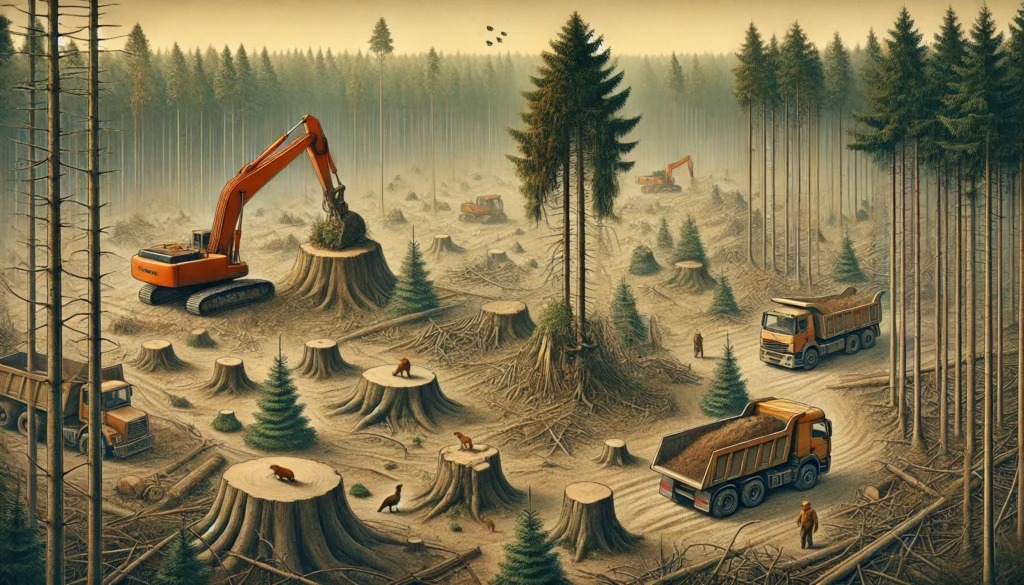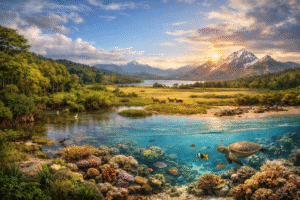Did you know that over half of the world’s forests have been destroyed due to human activity?
Welcome to a deep dive into a critical topic affecting every corner of our world: “How Human Activity Affects Global Ecosystem Stability.” In an increasingly interconnected world, human actions, from deforestation to industrialization, have transformed our planet. While progress has its benefits, our impact on ecosystems often comes at a high cost. Understanding this impact is key if we want to build a sustainable future for all. So, let’s unpack how our everyday choices influence the delicate balance of ecosystems around the globe.
How Do Human Activities Impact Ecosystems?
Human activities affect ecosystems on many levels, from local to global. Here’s a look at some of the main ways we impact the world around us and why this matters.
Deforestation and Habitat Loss
One of the most significant ways human activity disrupts ecosystems is through deforestation. Trees are often cut down for timber, agriculture, or urban development. The Amazon Rainforest, often referred to as “the lungs of the Earth,” has lost more than 20% of its trees to logging, agriculture, and wildfires. With every acre lost, we lose valuable plant and animal species, many of which haven’t even been discovered yet.
This deforestation not only reduces biodiversity but also contributes to climate change. Forests absorb large amounts of carbon dioxide (CO2), helping to regulate global temperatures. When forests are destroyed, that stored CO2 is released back into the atmosphere, further intensifying the greenhouse effect.

Pollution and Its Ripple Effect
Pollution is another major factor destabilizing ecosystems. There are several types of pollution affecting the environment:
Air pollution: Emissions from vehicles, factories, and burning fossil fuels release pollutants like sulfur dioxide (SO2) and nitrogen oxides (NOx), causing acid rain. Acid rain can change the pH of soil and water bodies, impacting plants, fish, and other aquatic organisms.
Water pollution: Wastewater, chemicals from factories, and oil spills pollute our oceans, rivers, and lakes. The Great Pacific Garbage Patch, a massive collection of marine debris, is an example of how plastic waste has taken over parts of our ocean, affecting marine life and polluting our food supply.
Soil pollution: Pesticides and chemicals used in agriculture can remain in the soil for years. Heavy metals, fertilizers, and pesticides in soil affect plants and can enter the food chain, harming animals and humans alike.
Climate Change and Its Chain Reaction
Climate change is one of the most profound examples of human impact on ecosystems. The increase in greenhouse gases (GHGs) like CO2 and methane (CH4) is driving global temperatures upward. This warming has far-reaching effects:
Coral bleaching: Rising sea temperatures are causing coral reefs to bleach and die. Coral reefs support about 25% of all marine life, so their loss has a ripple effect throughout the ocean ecosystem.
Melting ice caps: Melting glaciers and polar ice caps lead to sea-level rise, affecting coastal ecosystems and human settlements. For example, the Arctic is warming nearly twice as fast as the global average, threatening species like polar bears that rely on sea ice for survival.
Altered habitats: Animals and plants are shifting their habitats as temperatures change. Some species, like monarch butterflies, are facing decline due to these shifts, as they can’t adapt quickly enough to changing environments.
Overfishing and Marine Depletion
Oceans cover over 70% of the Earth, yet they’re increasingly vulnerable to human activities, particularly overfishing. Overfishing removes species faster than they can reproduce, threatening fish populations and the larger marine food chain. Tuna and cod populations have plummeted over the years due to high demand, leading to severe depletion and endangering countless marine species.
Marine life isn’t just about the ocean; it affects the global ecosystem. Fish are part of a delicate food chain, and when populations decline, predators and prey suffer, too. Sustainable fishing practices are essential if we want to preserve marine biodiversity.
Urbanization and Fragmentation of Natural Spaces
As cities expand, we encroach on natural habitats. Urbanization transforms forests, grasslands, and wetlands into roads, buildings, and other infrastructure, disrupting local ecosystems. This not only fragments animal habitats but also isolates populations, making it harder for animals to find mates, food, and shelter.
Urbanization also increases light pollution, which can confuse migratory animals like birds. Additionally, the heat produced by cities contributes to local climate changes, affecting urban wildlife and plant species.
Introduction of Invasive Species
Human travel and trade have unintentionally spread species across continents, sometimes with damaging consequences. Invasive species can dominate ecosystems by outcompeting native plants and animals for resources. For example, the introduction of the cane toad in Australia to control crop pests led to disastrous effects. Cane toads poisoned native predators and disrupted the local ecosystem, illustrating how introducing foreign species can lead to complex ecological consequences.
Solutions and Steps We Can Take
Addressing the impact of human activities on ecosystems requires collective action. Here are some steps that can make a difference:
Supporting Conservation Efforts: Organizations worldwide are working to protect forests, wetlands, and other vital ecosystems. Supporting these organizations through donations or volunteering can help them continue their important work.
Sustainable Choices: From reducing plastic use to choosing sustainable seafood, individual choices add up. Switching to eco-friendly products and supporting ethical brands can reduce demand for unsustainable resources.
Education and Advocacy: Raising awareness about ecosystem preservation can inspire change. Educate yourself and others, advocate for environmental policies, and vote for leaders who prioritize sustainability.
Conclusion
The impact of human activity on ecosystem stability is undeniable. From deforestation to climate change, we play a significant role in shaping our planet’s future. But while the challenges are vast, so are the opportunities for change. By making conscious choices, supporting conservation, and advocating for sustainable policies, we can work towards a more stable and thriving global ecosystem.
It’s up to all of us to be stewards of our environment. Together, we can help preserve Earth’s incredible biodiversity for future generations.
Author’s Note
As someone passionate about the environment, I believe understanding our impact on the planet is the first step toward positive change. Small actions, when combined, can create big differences. Let’s protect our home and all the life it supports.
G.C., Ecosociosphere contributor.
References and Further Reading
- World Wildlife Fund: Forests
- National Geographic: Effects of Climate Change
- Future Prospects and Challenges for Weasel Conservation | WeaselUniverse.com. https://www.weaseluniverse.com/blog/weasel_conservation/future_prospects_and_challenges_for_weasel_conservation.html
- Trees living fast die young – Priestley Centre for Climate Futures. https://climate.leeds.ac.uk/news/trees-living-fast-die-young/
- A Brief History of Plastic Pollution | Michael Tanha | Environmentalism Through Sustainability. https://michaeltanha.com/a-brief-history-of-plastic-pollution/
- Rahmanta, M., Rahmanta, M., Cahyo, N., & Supriyanto, E. (2024). Techno-Economic and Environmental Impact of Biomass Co-Firing with Carbon Capture and Storage in Indonesian Power Plants. Sustainability, 16(8), 3423.
- Scientists Identify New Polar Bear Population Uniquely Prepared for Climate Change | Discover Magazine. https://www.discovermagazine.com/planet-earth/scientists-identify-a-polar-bear-population-uniquely-prepared-for-climate
- Biosecurity: Measures, Examples & Importance | StudySmarter. https://www.studysmarter.co.uk/explanations/biology/ecology/biosecurity/
- Brown, K. (2009). Human development and environmental governance: A reality check. Cambridge University Press EBooks. https://doi.org/10.1017/cbo9780511807756.004
- The Future of Climate Change Research. https://research-studies-press.co.uk/2024/03/23/the-future-of-climate-change-research/





Comments
“This is content excellence at its finest! The depth of research and clarity of presentation sets a new standard. Your expertise in this field is truly impressive.”
“This is content excellence at its finest! The depth of research and clarity of presentation sets a new standard. Your expertise in this field is truly impressive.”